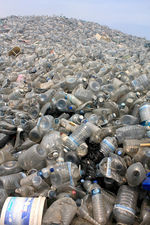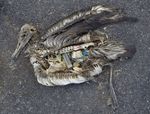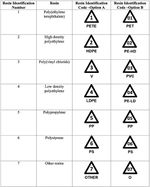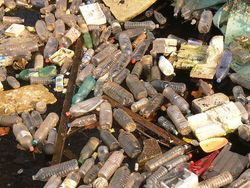Plastic pollution
Plastic pollution is caused by enormous number of plastic garbage people produce in their daily life. Some plastic is recycled and the accretion of plastic pollution not only evokes the destruction of the ecological environment but also becomes a current complication that can no longer ignored. Plastic pollution terribly influences the food chains due to its toxicity. More and more species die, and plastic pollution even cause some humans' modern illness. However, plastic is disposable, which means plastic pollution plastic products caused can consistently accumulates. By concentrating on recycling plastic pollution, people can make a great effort on reducing the harm of plastic pollution causes. People can work on reducing, reusing, recycling plastic products order to alleviate this problem. [1]
Basic Concepts

Plastic is a synthetic material, which consists of tiny disposable chemical particles, such as polyethylene terephthalate and polyvinyl chloride. They can easily be molded or shaped by hear or pressure. The composition of plastic could be divided to carbon-chain polymers and heterochain polymers on account of its different basis of composition. People utilize plastic products in their daily life, and it becomes an indispensable necessity for their lives. On the one hand, plastic products have profound benefits for people’s lives, but can also create harmful influences, because they are some types of toxic pollutants. Most plastic products are non-biodegradable, which could cause enormous damage to the natural environment. Plastic pollution leaves negative influence on the earth and species. Its toxicity is able to cause illness and death of the plants and animals.[2]The lethal nature of plastic pollution remains different impacts. The number of plastic consumption is unbelievably large—Lytle points out that “plastic consumption is to reach 297.5 million tons by the end of 2015.”[3]
Causes
The advantageous characteristics of plastic could also bring enormous problems to society. The current phenomenon of plastic pollution is formed progressively. Quite a bit of plastic products are properly collected and landfilled. Due to the properties of plastic and uncomplicated produce process, the cost of manufacturing is low, and people easily regard them. The existence of plastics can evoke harmful influence on the environment. Urbanization is another reason conduced plastic pollution. Especially in cities, people are capable of buying stuff made of plastics and this forms some dangers. In Mumbai, India in 1998, the plastic pollution clogged up the pipes of drainage lines and eventually resulted in scary flood.[4] Various contributors to this problem show that plastic pollution is partly caused by people’s lack of awareness. Due to people's lack of recognition of the seriousness of plastic pollution, plastic pollution strongly increase its adverse impacts on their lives without awareness. However, the large amount of plastic pollution constantly increases its number, causing some people’s attention. [5]
Accumulation of plastic products, such as peanut butter jars, soft drink bottles, garment bags, directly and dramatically increases the amount of plastic pollution. The durability of plastic leads to its non-degradation. [2] According to scientific report, nearly 90 percent of plastic products are only used once then just thrown away. One of the major causes of plastic pollution is plastic bags. The advantageous characters of plastic could also bring enormous problems to the society.[4]
Cosmetic factories add plastic scrubbers in cosmetics, such as facial scrubs and exfoliator. On account of the size of these plastic particles, they are able to intangibly flow through water-treatment plants. [6] The consequence of those developments of industrialization is bringing the harm and danger to the earth, negatively influencing humans, animals, and the environment. [2]
Effects

Plastic pollution causes great negative impact on the environment. Animals, ecosystem, humans’ lives and oceans are all influenced by plastic pollution, turning to a long-term issue. In order to solve this problem, each year governments in each country have to spend millions dollars, profoundly influencing the economics. For instance, every year US government spent thirteen billion dollars on solving problems ocean plastic pollution caused.[7]
Due to the toxicity of plastic, it messes up the food chains, which means it could remain in the food chains and gradually increase with the levels. No matter the size of species, they would more or less become poisoned when they directly or indirectly come to contact with plastic pollution. [8] As humans, people eat marine fish and mammals, so that ones have high possibility to ingest those toxic wastes. The associate professor, Rolf Halden, notes and concludes, “outline of health effects of plastics on humans is almost impossible to determine. This is due to the fact that the problem of plastic contamination in humans is globally spread,” which conveys that it is difficult to accurately measure how bad plastic pollution influence humans (qtd. in Andrews).[9]
Plastic pollution not only affects humans but also influences animals. For some marine animals, it’s difficult for them to distinguish their food from plastic microbeads, causing toxic damage on a big amount of marine life, even leading them to death. [6] A report points out that each year because of eating or getting entangled in plastic garbage, there are more than one million marine mammals die. [10]In addition, due to the toxicity of plastic pollution in soil, as the suitable areas for animals keep decreasing the size of the animals’ population that depend on those vanishing habitats. [2]
Solutions

Indeed, one of the most significant thing people need to be aware is the danger of plastic pollution. Each human being is supposed to take responsibilities for this situation. [11] Moreover, people are supposed to carefully distinguish plastic products and other metals, and they need to work on recycling those products separately instead of throwing them into the same garbage can. In order to strengthen the consciousness of the harm recycling of plastic pollution, education plays a profound role in this aspect. Teaching the new generation to recognize and identify the different symbols of plastic products, people could help them fall into the habits of distinguishing recycling methods of diverse series of plastic products and using less plastic items. For instance, the Roman numeral 2 generally appears on plastic bottles or grocery bags, which directs people to understand that those products are usually collected by curbside recycling programs.[11]
As responsible individuals, human beings ought to help to do 3R- reduce, reuse, and recycle, in order to alleviate the problem. If people still choose to ignore or do not perceive the severity of plastic pollution, people cannot bear the result of this problem. In order to reduce the adverse impacts of plastic pollution on environment, people came up diverse strategies.
Some of people’s daily plastic articles are usually used only by once then discarded. People could reuse them more than once due to some plastic produces’ reusable ability. When people go to the stores, instead of using plastic bags, they could bring their own shopping bags. Engler addressed that “Each year, close to 20 billion plastic bottles are tossed in the trash.” When people stay outside, they can drink water by local tap water or just bring their own water bottles with them. It’s more convenient and clean. By doing these, people are able to gradually fall into the habit of reducing the use of disposable plastics. [6]
In the Holy Bible, it talks about the beauty of the earth: “‘But ask the animals, and they will teach you, or the birds in the sky, and they will tell you; or speak to the earth, and it will teach you, or let the fish in the sea inform you. Which of all these does not know that the hand of the LORD has done this? In his hand is the life of every creature and the breath of all mankind.’” (Job 12: 7-10). God creates this fascinating earth for us to live on, so we have the responsibility of keeping its original beauty. It is the dwelling God granted us to live, and we must protect the earth with our best by all means.
Video
This video introduces several methods dealing with plastic solution.
Lisa Kaas Boyle talks about the potential policy solutions for preventing the damages caused by plastic pollution.
References
- ↑ Hasselberger, Lynn. 22 Facts About Plastic Pollution (And 10 Things We Can Do About It) EcoWatch. Web. Published Apr. 7, 2014.
- ↑ 2.0 2.1 2.2 2.3 Rinkesh. What is Plastic Pollution? Conserve Energy Future. Web. Accessed April 17, 2016, at 19:51.
- ↑ Lytle, Claire Le Guern. WHEN THE MERMAIDS CRY: THE GREAT PLASTIC TIDE Costalcare. Web. Last-modified April, 2016.
- ↑ 4.0 4.1 Plastic Pollution, Causes Of Plastic Pollution Due To Plastic Bags, Bottles, Containers, Recycled Plastics karmayog. Web. Accessed Apr. 26, 2016. Author Unknown.
- ↑ Relisser, Julia and Pattiaratchi, Charitha. Australian waters polluted by harmful tiny plastics The conversation. Web. Published Nov. 27, 2013.
- ↑ 6.0 6.1 6.2 Engler, Sarah. 10 Ways to Reduce Plastic Pollution NRDC. Web. Published January 5, 2016.
- ↑ Ocean Plastic Pollution Costs $13 Billion a Year, and Your Face Scrub Is Part of the Problem TakePart. Web. Accessed May 7, 2016. Author Unknown
- ↑ Moore, Charles. Plastic pollution Encyclopeddia Britannica. Web. Accessed May 1, 2016.
- ↑ Andrews, Gianna. Plastics in the Ocean Affecting Human Health Geology and Human Health. Web. Accessed May 1, 2016.
- ↑ Barry, Carolyn. Plastic Breaks Down in Ocean, After All -- And Fast National Geographic. Web. Published Aug. 20, 2009.
- ↑ 11.0 11.1 Prindiville, Matt. The Solution to Plastic Pollution? UpStream. Web. Published April 22, 2015.
| ||||||||||||||

